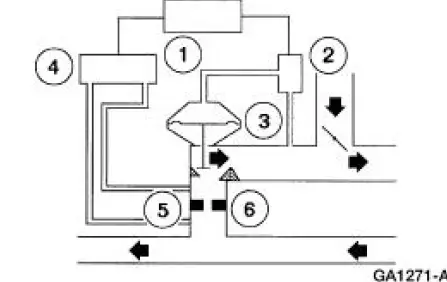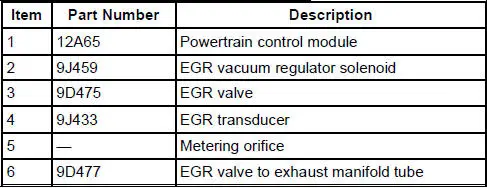Ford Mustang (1999-2004) Service Manual: EGR System Components


The EGR system returns a portion of the exhaust gas to the intake manifold to reduce the combustion temperature. This results in lower nitrous oxide formation.
The powertrain control module (PCM) controls the EGR vacuum regulator solenoid . The EGR vacuum regulator solenoid controls the vacuum to the EGR valve. When the EGR valve opens, exhaust gas flows to the intake manifold. The EGR transducer measures the flow through the EGR valve to exhaust manifold tube and sends a signal to the powertrain control module. A metering orifice in the EGR valve to exhaust manifold tube restricts the flow rate when the EGR valve is open.
The PCV valve:
- controls the amount of ventilating air and blow-by gases going to the intake manifold.
- prevents a backfire from reaching the crankcase.
The EGR valve to exhaust manifold tube:
- connects the exhaust manifold to the EGR valve.
- has two tubes connecting to the EGR transducer for EGR flow monitoring.
The EGR transducer:
- monitors the EGR flow rate through the EGR valve to exhaust manifold tube.
- sends an EGR flow rate signal to the powertrain control module.
The EGR vacuum regulator solenoid uses input from the powertrain control module to change the EGR valve operation.
Engine Emission Control (DIAGNOSIS AND TESTING)
Refer to the Powertrain Control/Emissions Diagnosis (PC/ED) manual.
 Typical Vehicle Emission Control Information (VECI) Decal
Typical Vehicle Emission Control Information (VECI) Decal
The Vehicle Emission Control Information (VECI) decal shows:
the components of the emission control system.
the correct vacuum hose routing.
the color stripe of the vacuum hoses.
...
 Exhaust Gas Recirculation (EGR) Valve
Exhaust Gas Recirculation (EGR) Valve
Removal and Installation
NOTE: The 4.6L, 2V is shown. The 3.8L is similar.
1. Disconnect the vacuum hose.
2. Disconnect the EGR tube from the EGR valve.
3. Remove the two bolts, the EGR valve an ...
Other materials:
Removal
1. Raise and support the vehicle.
2. Remove the wheel and tire assembly.
3. WARNING: Brake fluid contains polyglycol ethers and polyglycols.
Avoid contact
with eyes. Wash hands thoroughly after handling. If brake fluid contacts
eyes, flush eyes ...
Differential Housing Cover
Removal
1. Raise and support the vehicle.
2. NOTE: Empty the lubricant into a clean container for reuse.
Remove the differential housing cover (4033).
1. Remove the 10 bolts and drain the lubricant from the differential
housing (4010).
2. Remove the d ...
Key Programming - Erase All Key Codes and Program Two
Keys
Special Tool(s)
Worldwide Diagnostic System
(WDS)
418-F224,
New Generation STAR (NGS)
Tester
418-F052 or equivalent
diagnostic tool
NOTE: This procedure is used when a customer needs keys programmed
into the system and does
not have ...
